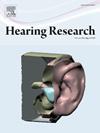Miguel A. Merchán and the Cajalian influence: Pioneering auditory neuroscience in Spain
IF 2.5
2区 医学
Q1 AUDIOLOGY & SPEECH-LANGUAGE PATHOLOGY
引用次数: 0
Abstract
This article traces the history of auditory neuroscience in Spain. It begins with the pioneering contributions of Santiago Ramón y Cajal, who meticulously described the organization of every region of the auditory system, from the cochlea to the cerebral cortex. His legacy continued with his disciples, Rafael Lorente de Nó, who conducted a detailed study of the cochlear nuclei, and Fernando de Castro, who later passed the baton to Jaime A. Merchán. Jaime Merchán revitalized Spanish auditory neuroscience and mentored his brother Miguel, whose contributions receive special focus.
Starting in the early 1980s, Miguel A. Merchán’s pioneering research has profoundly expanded our understanding of the structure and connectivity in the central auditory system. His collaborations, both within Spain and internationally, have played a pivotal role in shaping the field. As his career progressed, his research evolved to investigate the plasticity of the auditory system, and his recent work continues to explore innovative approaches to protect and restore hearing, with significant clinical implications.
Beyond his scientific accomplishments, Miguel Merchán’s influence as a mentor and administrator further highlights his enduring legacy. His contributions have not only advanced the field but have also nurtured the development of future generations of Spanish scientists, encouraging collaboration and innovation in the scientific community. His work continues to inspire emerging researchers, while his ongoing investigations into auditory system plasticity and protection hold promise for vital breakthroughs in the understanding and treatment of hearing loss and related disorders.
米格尔A. Merchán和卡加利亚人的影响:西班牙听觉神经科学的先驱
本文追溯了西班牙听觉神经科学的历史。它始于圣地亚哥Ramón y Cajal的开创性贡献,他细致地描述了听觉系统每个区域的组织,从耳蜗到大脑皮层。他的遗产通过他的弟子们继续传承,拉斐尔·洛伦特·德Nó对耳蜗核进行了详细的研究,费尔南多·德·卡斯特罗后来把接力棒传给了杰米·a·Merchán。Jaime Merchán振兴了西班牙听觉神经科学,并指导了他的兄弟Miguel,他的贡献受到了特别的关注。从20世纪80年代初开始,Miguel A. Merchán的开创性研究深刻地扩展了我们对中央听觉系统结构和连接的理解。他在西班牙国内和国际上的合作在塑造该领域方面发挥了关键作用。随着他事业的发展,他的研究发展到调查听觉系统的可塑性,他最近的工作继续探索创新的方法来保护和恢复听力,具有重要的临床意义。除了他的科学成就,米格尔Merchán作为导师和管理者的影响进一步凸显了他的不朽遗产。他的贡献不仅推动了这一领域的发展,而且还培养了西班牙未来几代科学家的发展,鼓励了科学界的合作和创新。他的工作继续激励着新兴的研究人员,而他正在进行的听觉系统可塑性和保护的研究有望在理解和治疗听力损失和相关疾病方面取得重大突破。
本文章由计算机程序翻译,如有差异,请以英文原文为准。
求助全文
约1分钟内获得全文
求助全文
来源期刊

Hearing Research
医学-耳鼻喉科学
CiteScore
5.30
自引率
14.30%
发文量
163
审稿时长
75 days
期刊介绍:
The aim of the journal is to provide a forum for papers concerned with basic peripheral and central auditory mechanisms. Emphasis is on experimental and clinical studies, but theoretical and methodological papers will also be considered. The journal publishes original research papers, review and mini- review articles, rapid communications, method/protocol and perspective articles.
Papers submitted should deal with auditory anatomy, physiology, psychophysics, imaging, modeling and behavioural studies in animals and humans, as well as hearing aids and cochlear implants. Papers dealing with the vestibular system are also considered for publication. Papers on comparative aspects of hearing and on effects of drugs and environmental contaminants on hearing function will also be considered. Clinical papers will be accepted when they contribute to the understanding of normal and pathological hearing functions.
 求助内容:
求助内容: 应助结果提醒方式:
应助结果提醒方式:


